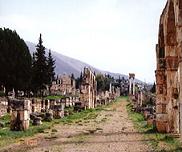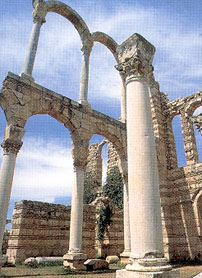Anjar
City
Profile Altitude:
930m
Distance from Beirut: 58km
Getting
There
From Beirut, take the Damascus Road. Upon reaching the Bekaa Valley, there is a
sign-post to the left 10 km after Chtaura. The ruins can be seen from the main
road. |

|
Anjar
Ruins
At other
historical sites in the country, different epochs and civilizations are
superimposed one on top of the other. Aanjar is exclusively one period, the Umayyad.
Lebanon's other sites were founded millennia ago, but Aanjar is a relative
new-comer, going back to the early 8th century A.D. Unlike Tyre and Byblos,
which claim continuous habitation since the day they were founded, Aanjar
flourished for only a few decades.
Other than a small Umayyad mosque in Baalbeck, we have few other remnants
from this important period of Arab History.
Aanjar also stands unique as the only historic example of an inland commercial
center. The city benefited from its strategic position on intersecting trade
routes leading to Damascus, Homs, Baalbeck and the south. This almost perfect
quadrilateral of ruins lies in the midst of the richest agricultural land in
Lebanon. It is only a short distance from gushing springs and one of the
important sources of the Litani River. Today's name, Aanjar, comes from the
Arabic Ain Gerrha, "the source of Gerrha", the name of an ancient city founded
in this area during Hellenistic times. Aanjar has a special beauty. The city's
slender columns and fragile arches stand in contrast to the massive bulk of
the nearby Anti-Lebanon mountains--an eerie background for Aanjar extensive
ruins and the memories of its short but energetic moment in history.
History, Aanjar's Masters, The Umayyads
The
Umayyads, the first hereditary dynasty of Islam, ruled from Damascus in the
first century after the Prophet Mohammed, from 660 to 750 A.D.
They are credited with the great Arab conquests that created an Islamic empire
stretching from the Indus Valley to southern France.
 |
|
Skilled in administration and planning, their empire prospered for a 100
years. Defeat befell them when the Abbasids--their rivals and their
successors--took advantage of the Umayyad's increasing decadence.
Some chronicles and literary documents inform us that it was Walid I, son of
Caliph Abd al-Malik ibn Marwan, who built the city--probably between 705
and 715 A.D.
Walid's son Ibrahim lost Aanjar when he was defeated by his cousin Marwan
II in a battle two kilometers form the city.
|
Excavating Aanjar
Just after Lebanon gained independence in 1943, the country's General
Directorate of Antiquities began to investigate a strip of land in the Beqaa
valley sandwiched between the Lebanon and Anti-Lebanon mountains some 58
kilometers east of Beirut. This was Aanjar, then a stretch of blend bareness
with parched shrubbery and stagnant swamps that covered the vast area of these
archaeological remains.
The site at first seemed painfully modest, especially when compared with
the rest of Lebanon's archaeological wonders. What attracted the antiquities
experts to Aanjar was not such the ruins themselves as the information they
held. Beneath the impersonal grayness of Aanjar, the experts suggested, lay
the vestiges of the eighth century Umayyad dynasty that ruled from Damascus
and held sway over an empire.
That idea was particularly interesting because Lebanon--that unique crossroads of the
ages--boasted ample archaeological evidence of almost all stages of Arab
history with the exception of the Umayyad.
Early in the excavation engineers drained the swamps. Stands of evergreen
cypresses and eucalyptus trees were planted and flourish today, giving these
stately ruins a park-like setting. To date, almost the entire site has been
excavated and some monuments have been restored.
Among the chief structures are the Palace I and the Mosque in the south-east
quarter, the residential area in the southwest, the Palace II in the northwest
and the Palace III and public bath in the northeast.
Aanjar Today
Aanjar is open daily. Close to the ruins of Aanjar are a number
of restaurants which offer fresh trout plus a full array of Lebanese and
Anjar Armenian dishes. Some of the restaurants are literally built over the trout
ponds. Aanjar has no hotels but lodging can be found in Chtaura 15 kilometers
away.
Information From the Ministry of
Tourism

|